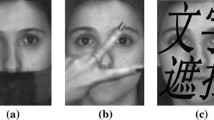Abstract
In this paper, we present a new Bayesian framework for partially occluded object recognition based on matching extracted local features on a one-to-one basis with object features. We introduce two different statistical models for occlusion: one model assumes that each feature in the model can be occluded independent of whether any other features are occluded, whereas the second model uses spatially correlated occlusion to represent the extent of occlusion. Using these models, the object recognition problem reduces to finding the object hypothesis with largest generalized likelihood. We develop fast algorithms for finding the optimal one-to-one correspondence between scene features and object features to compute the generalized likelihoods under both models. We conduct experiments illustrating the differences between the two occlusion models using different quantitative metrics. We also evaluate the recognition performance of our algorithms using examples extracted from object silhouettes and synthetic aperture radar imagery, and illustrate the performance advantages of our approach over alternative algorithms.
Similar content being viewed by others
References
Ansari, N. and Delp, E.J. 1990. Marital shape recognition: A landmark-based approach. IEEE Trans. Pattern Anal. Machine Intell., 12(5):470–483.
Baird, H.S. 1985. Model-Based Image Matching Using Location. MIT Press: Cambridge, MA.
Bertsekas, D.P. and Castañon, D.A. 1992. A forward/reverse auction algorithm for asymmetric assignment problems. Computational Optimization and Applications, 1:277–297.
Boshra, M. and Bhanu, B. 2000. Predicting performance of object recognition. IEEE Trans. Pattern Anal. Machine Intell., 22(9):956–969.
Boykov, Y. and Huttenlocher, D. 1999. A new Bayesian framework for object recognition. In Proc. IEEE Conf. Computer Vision and Pattern Recognition, vol.II., pp. 517–523.
Breuel, T.M. 1991. Model based recognition using pruned correspondence search. In Proc. IEEE Conf. Computer Vision and Pattern Recognition, Lahaina, Maui, Hawaii, pp. 257–262.
Chung, P.-C., Chen, E.-L., and Wu, J.-B. 1998. A spatiotemporal neural network for recognizing partially occluded objects. IEEE Trans. on Signal Processing, 46(7):1991–2000.
Costa, M.S., Haralick, R.M., and Shapiro, L.G. 1992. Optimal affine-invariant matching: Performance characterization. In Proceedings of SPIE-The International Society for Optical Engineering Image Storage and Retrieval Systems, Bellingham, WA, USA, vol. 1662. pp. 21–34.
Der, S.Z. and Chellappa, R. 1997. Probe-based automatic target recognition in infrared imagery. IEEE Trans. on Image Processing, 6(1):92–102.
Gold, S., Rangarajan, A., Lu, C.-P., and Pappu, S. 1998. New algorithms for 2D and 3D point matching: Pose estimation and correspondence. Pattern Recognition, 31(8):1019–1031.
Grimson, W.E.L. and Lozano-Perez, T. 1987. Localizing overlapping parts by searching the interpretation tree. IEEE Trans. Pattern Anal. Machine Intell., PAMI-9(4):469–482.
Hummel, R. and Wolfson, H. 1988. Affine invariant matching. In DARPA Image Understanding Workshop.
Huttenlocher, D.P., Klanderman, G.A., and Rucklidge, W.J. 1993. Comparing images using the hausdorff distance. IEEE Trans. Pattern Anal. Machine Intell., 15(9):850–863.
Jonker, R. and Volgenant, A. 1987. A shortest augmenting path algorithm for dense and sparse linear assignment problems. Computing, 38:325–340.
Lamdan, Y. and Wolfson, H. 1988. Geometric hashing: A general and efficient model-based recognition scheme. In Proc. Int. Conf. Computer Vision, Los Alamitos, CA, pp. 238–249.
Li, S.Z. 1995. Markov Random Field Modeling in Computer Vision. Springer-Verlag: Berlin.
Nemhauser, G.L. and Wolsey, L.A. 1988. Integer and Combinatorial Optimization. John Wiley & Sons: New York.
Olson, C.F. 1998. A probabilistic formulation for Hausdorff matching. In Proc. IEEE Conf. Computer Vision and Pattern Recognition, pp. 150–156.
Ratches, J.A., Walters, C.P., Buser, R.G., and Guenther, B.D. 1997. Aided and automatic target recognition based upon sensory inputs from image forming systems. IEEE Trans. Pattern Anal. Machine Intell., 19(9):1004–1019.
Reid, D.B. 1979. An algorithm for tracking multiple targets. IEEE Trans. on Automatic Control, AC-24(6):843–854.
Richards, J.A., Fisher, J.W., and Willsky, A.S. 2000. Target model generation from multiple SAR images. In SPIE: Algorithm for SAR Imagery VII.
Rigoutsos, I. and Hummel, R. 1995. A Bayesian approach to model matching with geometric hashing. Computer Vision and Image Understanding, 62(1):11–26.
Sim, D.-G., Kwon, O.-K., and Park, R.-H. 1999. Object matching algorithms using robust Hausdorff distance measures. IEEE Trans. on Image Processing, 8(3):425–429.
Velten, V., Ross, T., Mossing, J., Worrell, S., and Bryant, M. 1998. Standard SAR ATR evaluation experiments using the MSTAR public release data set. In Algorithms for Synthetic Aperture Radar Imagery V, E.G. Zelnio (ed.), Proc. SPIE vol. 3370, pp. 566–573.
Weber, M., Welling, M., and Perona, P. 2000. Unsupervised learning of models for recognition. In European Conference on Computer Vision.
Wells, W.M. 1997. Statistical approaches to feature-based object recognition. Int. J. Computer Visision, 21(1/2):63–98.
Ying, Z. 2002. Statistical approaches for partially occluded object recognition. Ph.D. Thesis, Boston University.
Ying, Z. and Castañon, D. 1999a. Statistical model for human face detection using multi-resolution features. In Proceedings IEEE International Conference on Information, Intelligence and Systems, pp. 560–563.
Ying, Z. and Castañon, D. 1999b. Statistical model for occluded object recognition. In Proceedings IEEE International Conference on Information, Intelligence and Systems, pp. 324–327.
Ying, Z. and Castañon, D. 2001. Feature based object recognition using statistical occlusion models with one-to-one correspondence. In Proc. Int. Conf. Computer Vision, Vancourver, Canada.
Ying, Z. and Castañon, D. 2002a. Correspondence for nonrigid object recognition. In International Conference on Computer Vision, Pattern Recognition and Image Processing, Durham, NC, USA.
Ying, Z. and Castañon, D. 2002b. Object recognition with spatially correlated occlusion. In International Conference on Computer Vision, Pattern Recognition and Image Processing. Durham, NC, USA.
Author information
Authors and Affiliations
Rights and permissions
About this article
Cite this article
Ying, Z., Castañon, D. Partially Occluded Object Recognition Using Statistical Models. International Journal of Computer Vision 49, 57–78 (2002). https://doi.org/10.1023/A:1019881831890
Issue Date:
DOI: https://doi.org/10.1023/A:1019881831890




